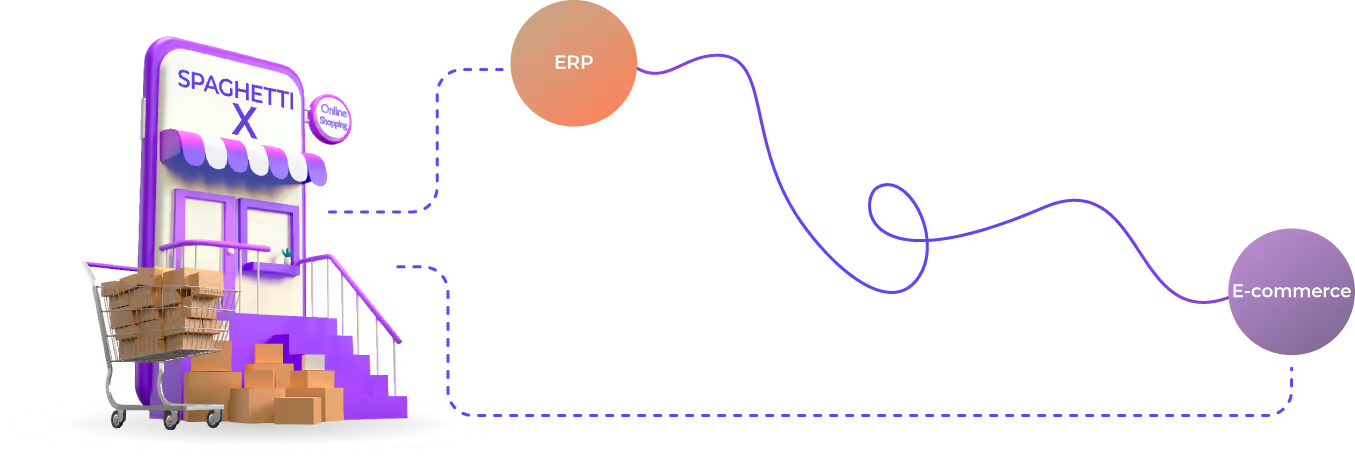Untangle your IT ecosystem with an iPaaS
Summary
To keep up with the rapidly evolving digital world, companies digitalize and automate their business processes by integrating various software solutions and cloud applications. From e-commerce, ERP, CRM, PIM, WMS, and many other such systems, the number of these applications that businesses have to integrate with is constantly increasing. Traditionally, businesses chose to integrate these software solutions in a point-to-point fashion (using custom-code) and without investing in scalable IT infrastructure. In the long term, this usually results in IT ecosystems that are entangled with data silos, scattered software connections, integration errors, and black box issues (lack of visibility and transparency). Thus, the true challenge in building a future-proof integration strategy lies in ‘How’ businesses choose to create these application integrations to enable business automation.
The Alumio iPaaS (integration Platform as a Service) is a next-gen, cloud-native platform that helps integrate unlimited systems, SaaS (Software as a Service), apps, and data source, via a user-friendly interface. It provides scalable infrastructure, workflow automation capabilities, and data transformation features required to seamlessly integrate and organize all the software solutions of a business on one platform, in a way that’s flexible, scalable, future-proof, and most importantly - untangled.
The need to build application integration ecosystems

91% of businesses are engaged in some form of digital initiative, and 87% of senior business leaders say digitalization is a priority"
It all starts with the need for digital transformation…
Digital transformation involves implementing digital technology and applications to automate various business processes of a company, from Marketing, Sales, Customer service, Procurement, HR, Supply Chain, and all other departments. This involves implementing software solutions (SaaS) or cloud apps , such as e-commerce platforms, ERP systems, CRM, PIM, WMS, POS, marketing automation apps, or other systems. Essentially, these applications that companies implement become part of their IT ecosystem.
Implementing these apps helps automate a plethora of costly, time-consuming, and manual repetitive work processes such as hiring, emailing, invoicing, product information optimization, inventory updates, customer relationship management, and thousands of business processes across various departments. This digitalized automation helps boost operational efficiency, it improves focus on revenue-generating core business activities, and above all, it results in more accessible and real-time customer experiences.
To add to this, the expectations and demands of customers for digital services and real-time experiences are also evolving, further driving the need for companies to integrate new applications. The absence of an e-commerce platform, email automation solution, or multiple payment option integrations can negatively impact how customers perceive a brand and its services.

Executives say digital transformation’s top benefits include improvement of operational efficiency (40%), faster time to market (36%), and meeting customer expectations (35%)."
… But digital transformation can also end up in complex entanglements
While implementing multiple applications to enable digital transformation and business automation in the short term, in the long term it leads to a plateful of problems. Namely, “Software Spaghetti” problems.
The more applications that a business implements and integrates, the more challenging it becomes to manage these connections and the resulting data exchange. This leads to an increasingly entangled IT ecosystem. Such an entangled IT ecosystem consists of data silos and a jungle of crisscrossing data flows. It also involves many partially connected software solutions, managed by multiple integration partners, overlapping and connecting to each other in a disorganized fashion. Because of the imagery that such an entangled IT landscape evokes, it is also known as an ‘Software Spaghetti Ecosystem’.
So, the question is - how and when do these business-automating application integrations get ‘pasta’ point (pun intended) and turn into Software Spaghetti Nightmares? Read on to untangle the plot!




















